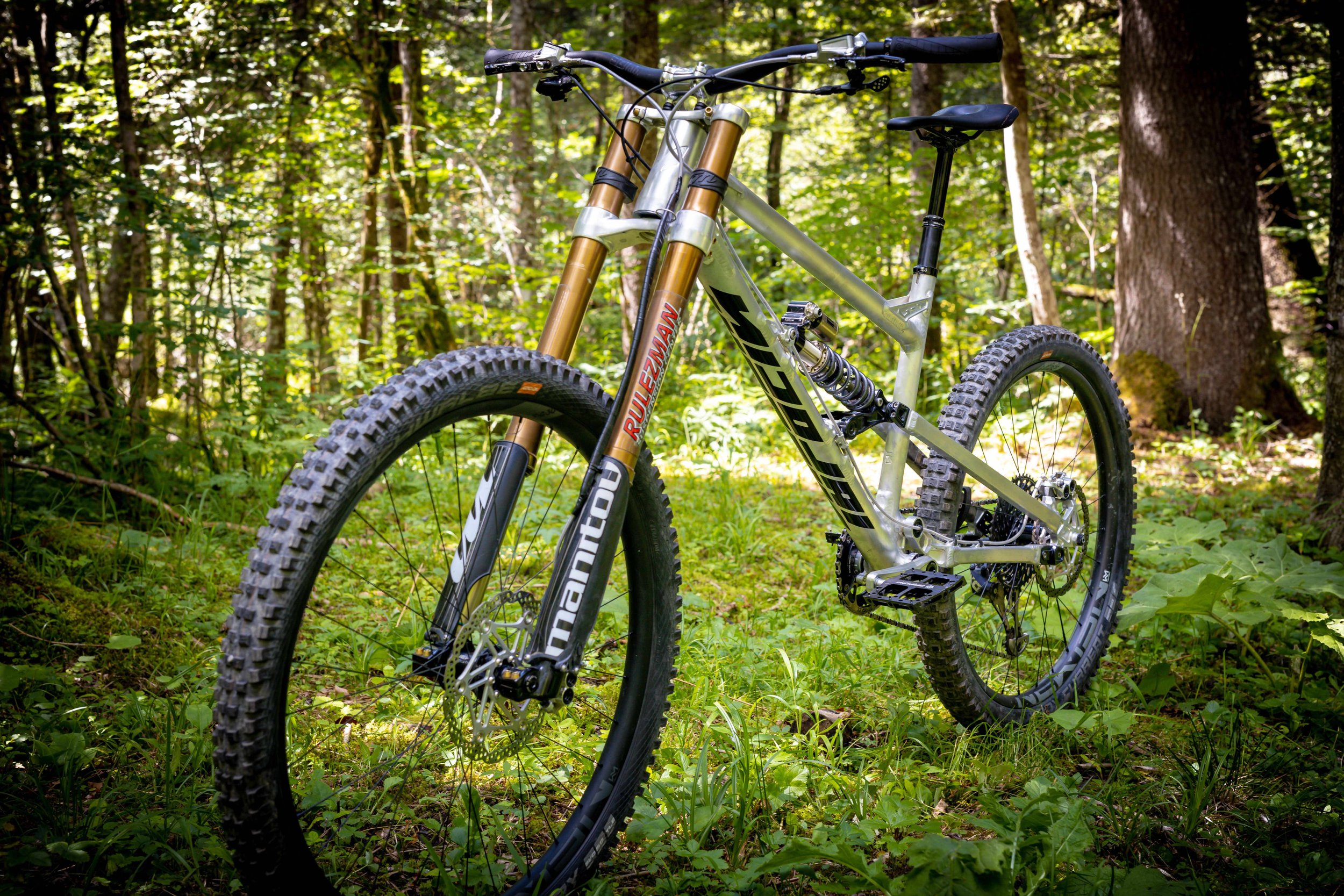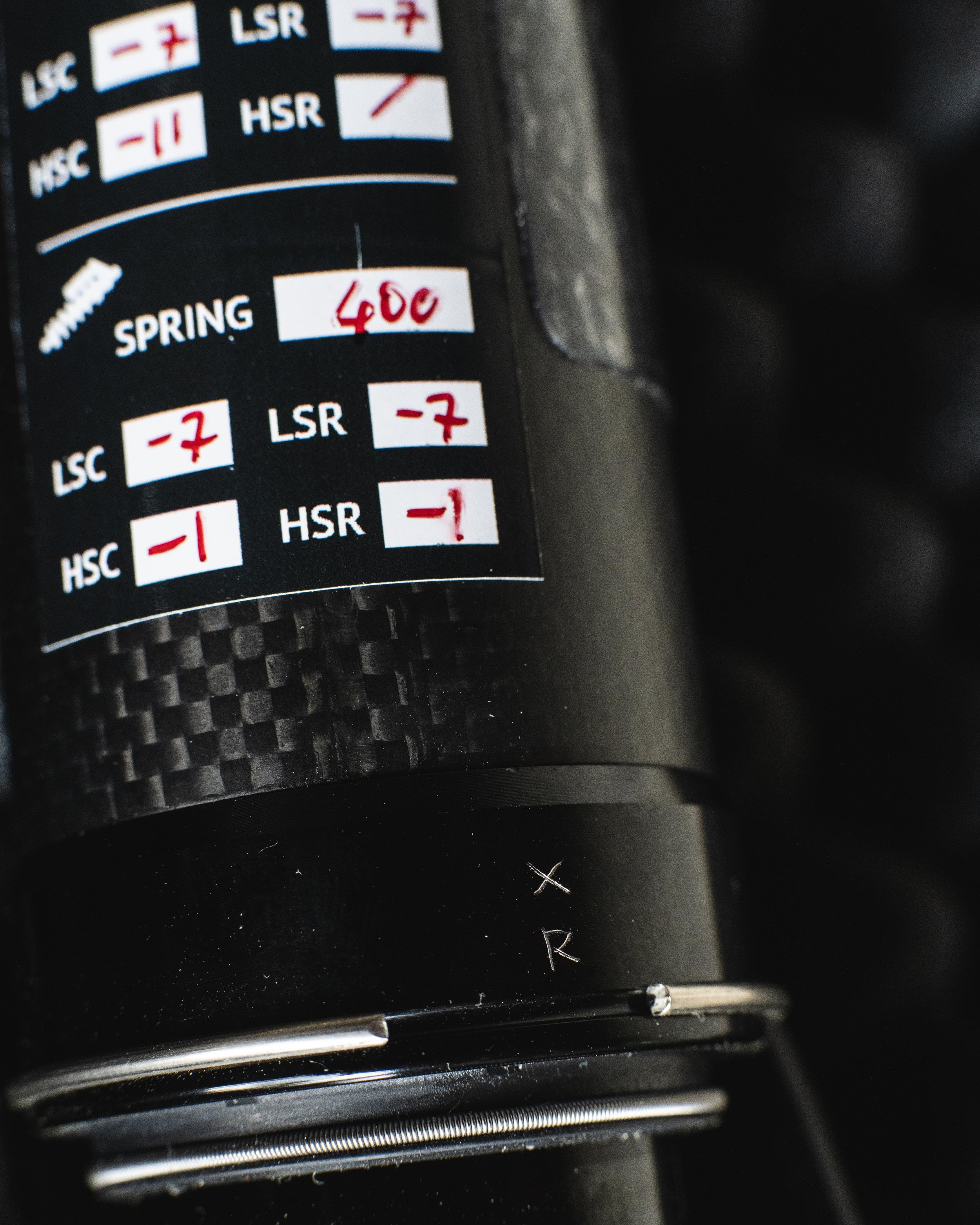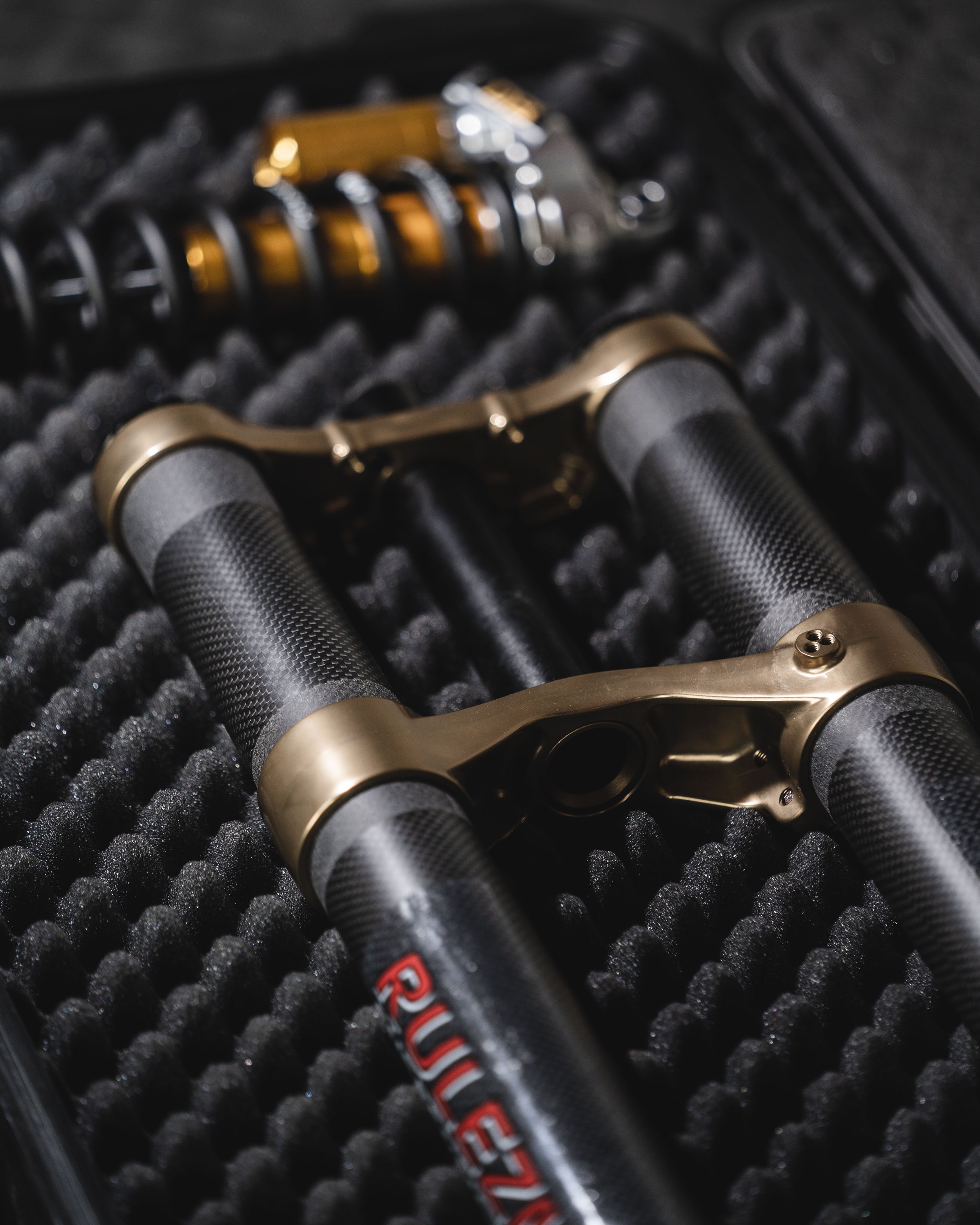Manitou Dorado RRT -Review
Intro
This is probably the best enduro/DH/eMTB fork money can buy and the closest you will get to a Factory Supercross fork.
I get many comments saying that it is unfair to compare tuned products against stock products, and I agree. Where I disagree, and always try to send home this message, is you should buy your suspension from a reputable tuner and get them dialled from Day 1. Avoid any problems with sticky bushings, too much grease on the air spring ports, too little lubrication oil, badly bled dampers, faffing around with settings and wasting precious trail time.
“But it costs loads more from a tuner?!” In reality, it doesn’t. Okay, if you compare it to buying a complete bike (I recommend sending any new suspension off to a tuner, though the fight against the temptation to ride it is high) or on discount then yes, but looking at correct retail prices, then not really.
For example, this Dorado RRT costs €2700 (LE versions with custom colours are €3300) from Rulezman. This includes a fork that is fully stripped down out of the box and rebuilt to perfection including bushing calibration, sliding surface treatment and lots of other stuff that Dave won’t disclose that he learnt over 15 years of Dorado work. This price also includes the custom drop top crown so it actually fits on most bikes, custom-tuned damper + airspring, base settings, aftersales advice, a real-life dyno readout and is topped off with titanium bolts all around.
Compare this to an off-the-shelf €2400 Fox 40 or a new Rockshox Boxxer at €2279 and the price looks pretty damn good!
Pure Bike Porn.
Get your base settings from Day1!
My first Dorado RRT - this was built on this older 36mm stanchion chassis. Absolutely incredible offering 210mm travel to match the 210mm rear of this ground breaking custom G1 from 2020.
Carbon or Alloy?
I’ve had a carbon version (on the Commencal Supreme Supreme) and an alloy version on my Egerie Ti-Ton-A-Tron and the Sunn Radplica.
My first days with the carbon version, were, well, scary! Not the riding, but the installation. Clamping down the crowns onto the carbon tubes is worrying compared to the alloy. Sliding the carbon legs into the crowns caused some scratching and surface damage so I learned to remove these steel spacers before any leg adjustments/removal to avoid this problem.
The next issue was the inside of the crowns where they pinch together was also quite sharp and bit into the outer legs, quite terrifying on such an expensive unit. Much less to worry about with the alloy version and after my problem, Rulezman now smoothes the inside of all the stock crowns. Manitou should look into fixing this in the manufacturing process.
Stiffness? The carbon fork did feel stiffer on the trail, but I don’t think it will be necessary for most riders, the alloy fork is plenty stiff enough when it is set up correctly and your mindset has shifted from a conventional fork to the incredible tracking and compliance of a USD fork.
My carbon legs after the first weekend of testing. Superficial but not nice after you handed over the cash for one of these weapons!
The back of the custom drop crown is cut out to avoid hitting any top tubes.
Later, I started to remove this plate when moving the legs, and filed down the inside of the crown to stop it biting into the carbon.
Compliant frame + compliant fork + plenty of damping = best tracking bike I ever had.
Custom Drop Crown
Manitou dropped the ball here in my opinion. The standard 29” fork crowns only allow up to a 110mm headtube height which seems restrictive in 2023 with stack heights rising and more people wanting to fit these kinds of forks to eMTB’s. Rulezman went straight to task here and designed and ordered a bunch of custom drop crowns meaning they will fit up to a 155mm headtube. The crown is also nicely cut out on the back to help avoid any contact with the top tubes on some bikes.
The same silver fork with some black vinyl to match the Sunn Radical ‘Radplica’
Downsides
These USD forks do require more attention than a normal fork and straightening them is needed often. You can perfectly align the fork by unbolting everything on the fork, tightening the lower crown, and then connecting a shock pump to the main air chamber which allows you to fully compress the fork (air passes into the pump).
Once compressed, you can tighten the bolts in order: lower crown bolts, main axle bolt, left-hand side axle pinch bolts, right-hand side axle pinch bolts, upper crown legs, steerer tube crown clamp and then your direct mount stem. This will give you perfect alignment and a noticeable benefit in reduced friction.
Every time you crash you’re going to need to do this, and if you want ultimate performance then every 4-5 DH runs would help. At least with a USD fork construction, you’re unlikely to damage anything in a crash whereas a conventional magnesium casting can be twisted in a crash and it’s hard to recognize visually, but could be affecting performance levels.
Air-bleed
The air bleeders on the Pro Carbon fork are press buttons that bleed any excess air out in a flash. Annoyingly, Manitou only specs these on the top version and the lower spec Expert and Comp forks have 2.5mm hex screws to remove.
The internal air build-up does create a slightly firmer fork, but can get frustrating to unscrew manually before every run if your a perfectionist bike dork like me. More difficult on my fork is that the bleed ports are hidden under the handlebar, this is bad luck as Rulezman specifically aligns the legs in a certain way for the best bushing fit and this left my bleeders in a bad location.
I ended up permanently leaving a 2.5mm ball end hex key under the frame bumper ready to use. It’s a small performance benefit, but once you start feeling it you have to do it every run! Of course, this issue happens on all forks, the zip-tie slid between the seals was the old trick but now many forks are coming with bleeder valves to easily alleviate air, well, not RS anymore after Fox sued them over it.
When it comes to sensitivity, another great benefit of a USD fork is that gravity means the lower bushing and seals are always lubricated, and the seals aren’t 10mm away from all the mud, dust and water spraying off the front tyre. The seals on the USD are facing down so mud and water drains off, and are further protected by the stanchion guards. I haven’t measured this specifically, but I would say the service intervals of the lowers are 10x that of a conventional fork. I’ve been riding these forks for months on end and they never seem to get sticky.
The ‘R’ reminds you its the right leg and the ‘X’ shows how to align the legs perfectly for minimal friction fore-aft and less side-to-side.
The Carbon Pro fork comes with bleed buttons, but the cheaper models need a 2.5mm hex.
Riding
My first few days on the previous model Dorado RRT 36mm did feel vague compared to conventional forks I was used to–I was using a Fox40–the stiffest fork on the market before swapping over. Vague in fast-bermed corners and flexy in angled rock and root. It took some while to work this one out, but I only felt any undesirable vague- or flexy-ness when I wasn’t running enough compression damping. Luckily, this only happened on the first 36mm Dorado RRT I used back in 2018 and the reason why you should build a relationship with a tuner; the first settings were estimated to work well for my weight and style. After giving feedback and trying a few things we were in a really good place. The following forks I bought started in the good place!
Why the vagueness? Not enough LSC on the bermed and flat corners means the fork is bobbing into its travel too much combined with twisting more than a normal fork.
Why the flexy feeling? Not enough HSC in the rock and root means if you hit a sharp obstacle, the front wheel accelerates through the travel too easily and the wheel will come off the ground; add to this all the bump forces going into the fork and the wheel are loading up in all sorts of directions and when the tyre leaves the ground, the wheel will rebound off in a random direction before it re-aligns itself. This gives a clear feeling of a flexy fork.
At this point, I think most people want to give up, blame the fork for being too flexy, and go back to normal. But, wind on enough clicks of LSC to keep the fork close to the sag point when pushing into corners and it feels incredible. Wind on enough HSC to keep the wheel glued to any sharp edges and the world is your oyster. You will be charging harder and faster than ever into corners and through the chunk. You will be leant over on in places you never thought possible and you will be holding lines and carving up off-camber to high lines you didn’t know existed.
Thanks to the USD design the entire upper section of the fork is incredibly stiff and the connection through the stem to your hands is very direct and very easy to feel. The first time you hit a huge square edge or land a jump to flat is pretty special too: much less flex in the chassis compared to a conventional fork (you’ve all seen the Huck-to-Flat videos on Pinkbike where most forks banana and stick-shift 3-4 times through the travel) means much less binding/stiction and a much smoother ride.
The USD design increases in stiffness the harder you go and the deeper into the travel you get: you can lean back slightly to let the fork ride higher in the travel and allow more flex if you need to carve across something loose and bumpy and it will track amazingly, but, the harder you push into things the better it gets.
When perfectly aligned and air-bled, the small bump sensitivity is incredible, even if you don’t, it’s still better than pretty much any fork you’ve ever tried. Mid-stroke support is massive, and bottom-out resistance is, well completely bottomless. Thanks to plenty of HSC, a hydraulic bottom-out and a massive rubber bottom-out bumper, I have never, ever, felt one of these forks bottom out and have never measured more than 195mm travel used. I think this is the perfect amount of bottom-out force as I don’t believe you ever want to bottom out a fork: if you can use most of the travel riding normally, but there is a little left in reserve for those ‘oh-shit’ moments then you should be safe: you don’t want to be fully compressed into a push-up position at your strength limit and then bottom out as this will probably overwhelm you and blow your hands off the bars or make you collapse into the bike.
I did this exact thing in Chatel Bike Park last year: I slipped on a root before the take-off of a jump and a wet and rooty black trail, I took off out of control in an angled nose-dive heading straight towards a drainage ditch. I’d already gone through the rehab plan in my mind and worked out how to find a driver to return my van home while I prepared for months of injury, then I landed the front wheel fully in the ditch, I hit my chest on the bars…
… and just rode it out like nothing had happened - that was the 195mm of used travel day!
Another place where these forks are night and day better in performance than any traditional fork I have used is during braking in steep and rough trails. The final section of the red ‘freeride’ trail at my local park has an extremely steep final 100m. This section is rutted out down to the bedrock and also zigged with roots. The speeds aren’t high here, but the load on the front wheel is heavy; the control and grip is incredible where a normal fork can start to struggle with friction from bending and also bogging into the travel. The fork just stays high, doesn’t bind and glues the tyre to any angle in your way.
My final note on riding is that for some reason that I can’t really explain, on sharp and tight corners these forks excel: but they seem to load up and twist in the corner, grip like hell and then launch you out of it.
Improvements?
Could it get any better? Well, not really. The only thing I can think of would be to pop a coil spring in there to further reduce friction and when I have some spare £££ I want to buy and test the coil-sprung Comp version of this fork to try out.
The second would be a one-piece mudguard/lower stanchion guard (a la original DVO Emerald) to increase the direct feeling at the bars. I believe (and have been told this by two engineers and two top suspension brands) that most vagueness felt by riders on a USD fork isn't from the fork twisting–as the classic car park test people do by putting the wheel between their legs and twisting the bar–but is from the two stanchions not travelling vertically together meaning the wheel travels in a wavy S-shape through the travel. This lower guard would help to solve that: If somebody made a nice carbon one in 3x different stiffnesses for different riders would be great!
Verdict
Yes, it is a lot of money, but if you want the best performance it comes at a price: and spending the extra £££ here will pay off more than lightweight tuning parts or choosing XX over XO ever will. The only fork I’ve ever used that comes a close second is my NSR damped and coil-sprung BoXXeR. Nothing off the shelf comes close and I don’t know of any brands offering anything at this level: if anybody thinks they can build something better than this please get in touch and I’ll take one!
Funding
I buy all the products you see on my site at full price or through online sales and these independent reviews are 100% crowdfunded by you guys buying competition tickets. This month, you can win a Limited Edition Dorado RRT number LE11! This Showa-replica fork is bolted to the incredible Banshee Legend RRT chassis and comes with a custom-built Cane Creek DB shock and an HCV1 Handlebar Clamp and headset.
To win this package all you need to do is head to my competition site, answer a simple question and you have an extremely good chance to win: current odds at the time of publishing this article are 1/99!
As always, all prizes are for brand-new products.
Global shipping is also included so entrants are invited from anywhere in the world.
The giveaway is guaranteed to happen on the end date regardless of how many tickets are sold. No extensions, no minimum ticket sales.
These competitions fund my reviews which I believe are the only truly independent MTB reviews online. All of the prizes and all of the products you see are bought by me - no sponsored posts, no freebies and no back-handers.
Thanks, Paul.

















